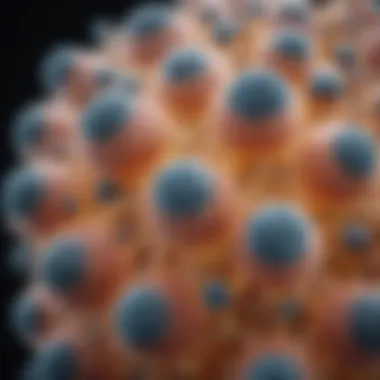Exploring Micrococcus luteus: Characteristics and Applications


Intro
Micrococcus luteus, a notable member of the Micrococcaceae family, presents a unique profile worthy of investigation. Understanding this bacterium involves delving into its characteristics, applications, and broader significance in various fields such as biotechnology and medicine. Recent studies have shed light on its role in environmental processes and potential impacts on health, particularly concerning antibiotic resistance. This overview will explore the essentials of M. luteus, offering insight into its relevance in contemporary scientific discourse.
Research Overview
Summary of Key Findings
Micrococcus luteus has shown a capacity for adaptation across diverse ecological niches. Its resilience in various environments contributes to biogeochemical cycles, such as carbon and nitrogen cycles. Additionally, M. luteus has been associated with both beneficial applications in biotechnology, such as bioremediation, and potential risks due to its antibiotic resistance characteristics.
Methodologies Employed
The study of M. luteus typically involves a mixture of microbiological techniques, genomic sequencing, and metabolic profiling. Researchers commonly employ culture methods to isolate the bacterium, followed by molecular techniques for phylogenetic analysis. In examining its metabolic pathways, advanced techniques like mass spectrometry are often utilized.
In-Depth Analysis
Detailed Examination of Results
Current research demonstrates that Micrococcus luteus exhibits notable metabolic versatility. It can thrive in various environments and has been shown to degrade environmental pollutants. Research also highlights its role in the human microbiome, where it can contribute to skin health and immune response. However, certain strains possess antibiotic resistance, raising concerns about its impact on human health.
Comparison with Previous Studies
When comparing M. luteus to other bacteria in the same family, it distinguishes itself through certain unique traits. Earlier studies primarily focused on its ecological role without adequately addressing its pathogenic potential. Recent literature has bridged this gap, emphasizing the need for a more comprehensive understanding of its dual nature as both a beneficial and potentially harmful organism.
"Micrococcus luteus, while largely benign, holds secrets to both ecological utility and medical implications that warrant deeper exploration."
In summary, understanding Micrococcus luteus requires a nuanced approach that considers its multifaceted roles in both the environment and human health. Further exploration into its characteristics promises to yield valuable insights into its applications across various fields.
Prelude to luteus
The introduction to Micrococcus luteus lays the groundwork for understanding this intriguing bacterium. It is essential to recognize its biological significance and applications across various fields. As a component of the environmental microbiome, M luteus plays vital roles in ecological and biotechnological processes. Understanding its characteristics enhances the grasp of its potential benefits and implications.
Definition and Overview
Micrococcus luteus is a gram-positive bacterium commonly found in soil, water, and on the surfaces of animals and humans. It has spherical cells and is non-motile, which means it does not move on its own. This bacterium is known for forming yellow colonies, often due to the production of carotenoid pigments. M luteus is part of the family Micrococcaceae and is noted for its metabolic versatility. This versatility allows M luteus to thrive in diverse environments, making it a key player in various biogeochemical cycles.
Historical Context
The discovery of Micrococcus luteus dates back to the late 19th century. Initially identified by scientists studying bacteria in soil, its significance has grown over the years as more applications became evident. Researchers have gradually understood its role in the ecosystem and its potential utility in biotechnology, especially in enzyme production and bioremediation. Early classification efforts placed M luteus in the broader context of microbial life, linking it to various environmental processes and applications in industry. The historical evolution of understanding M luteus reflects broader trends in microbiology, particularly in recognizing the potential of microorganisms beyond pathogenic roles.
Taxonomy and Classification
Taxonomy and classification are crucial for understanding Micrococcus luteus. This bacterium serves as a point of study for biologists, ecologists, and medical researchers. Proper classification helps establish its relationships with other organisms. Understanding its taxonomy aids in identifying ecological roles and potential applications.
Phylogenetic Position
The phylogenetic position of M luteus situates it within the family Micrococcaceae. Through DNA sequencing and molecular techniques, scientists have been able to define its genetic relationships. M luteus shares common ancestry with species such as Micrococcus varians and Micrococcus roseus. This shared lineage indicates an evolutionary path which can inform both ecological and clinical research. Understanding these relationships is significant for elucidating its behaviors and applications in biotechnology and medicine.
Genomic Characteristics
Genomic studies of M luteus reveal important characteristics that distinguish it. The bacterium has a relatively small genome, approximately 2.3 million base pairs. It contains genes responsible for its metabolic pathways, allowing for diverse energy sources. Notably, these genomic features could enable M luteus to thrive in various ecological niches.
Furthermore, its genome is of interest in antibiotic resistance research. Analyzing its genes can give insight into resistance mechanisms. This can help develop better treatment strategies against pathogenic bacteria. Understanding the genomic characteristics aids in comprehending how M luteus interacts within its environment, including its potential applications in bioremediation.


"The genetic makeup of Micrococcus luteus provides a foundation for its ecological roles and applications in modern science."
In summary, taxonomy and classification of M luteus offer a framework for its study. This includes understanding its phylogenetic history and genomic characteristics. Such insights are essential for further research and applications across multiple fields, from ecology to medicine.
Morphological and Physiological Attributes
Understanding the morphological and physiological attributes of Micrococcus luteus is essential for appreciating its role in various environments and its applications in biotechnology and medicine. These characteristics not only define the bacterium at the cellular level but also influence its metabolic capabilities, ecological interactions, and responses to external stimuli. A closer examination provides insight into how its physical and functional properties enable it to thrive and perform specific tasks across diverse applications.
Cell Structure
The cell structure of M luteus is primarily characterized by its spherical shape, which is a typical feature of cocci bacteria. It is a Gram-positive organism, possessing a thick peptidoglycan layer in its cell wall. This layer plays a crucial role in providing structural integrity and resistance to physical stresses.
The cell membrane encloses the cytoplasm and various intracellular components, including ribosomes, DNA, and enzymes that facilitate metabolic processes. The presence of unique polysaccharides in its capsule can contribute to the bacterium's ability to adhere to surfaces, enhancing its survival in diverse environments. The coccus morphology can also affect how M luteus interacts with other microorganisms, as its arrangement can influence colony formation and competition for resources.
"The distinct cell structure of M luteus enables its survival in harsh environments, promoting its utility in biotechnological applications."
Metabolic Pathways
Micrococcus luteus exhibits fascinating metabolic pathways that underscore its versatility. As an aerobic bacterium, it requires oxygen for growth and relies on aerobic respiration to generate energy. Notably, it can metabolize a range of substrates, including carbohydrates and fatty acids, which highlights its adaptability to different environments.
Its metabolic pathways involve complex biochemical reactions, including:
- Glycolysis: This pathway allows the breakdown of glucose to produce ATP, which is essential for cellular energy.
- Krebs Cycle: M luteus enters the Krebs cycle after glycolysis, further breaking down products to extract energy.
- Beta-oxidation: The capacity to metabolize fatty acids through this process is particularly significant for the bacterium's survival when simpler sugars are unavailable.
Through these metabolic pathways, M luteus participates in important biogeochemical cycles, impacting nutrient cycling in ecosystems. Moreover, knowledge of its metabolic processes feeds into its applications in bioremediation and enzyme production. Understanding these pathways helps researchers optimize conditions for desired reactions, making them integral to advancements in biotechnology.
Ecological Role of luteus
The ecological role of Micrococcus luteus is significant in various environments. As a member of the diverse bacterial community, it contributes to numerous biodegradation processes. Understanding the ecological importance of M. luteus provides insights not only into its benefits but also the considerations needed for its interactions within ecosystems.
Habitat and Distribution
M. luteus can be found in a variety of habitats, including soil, water, and even on the skin of mammals. Its versatility allows it to thrive in environments ranging from arid deserts to aquatic ecosystems. The adaptability of this bacterium makes it a common isolate in microbiological studies.
It is especially abundant in areas rich in organic matter, such as compost or decaying plant material. This bacterium is able to withstand extreme conditions, demonstrating resilience in both high and low temperatures. Its distribution is not limited to any single geographical area, highlighting its ubiquitous nature across different climates worldwide. This broad habitat range signifies its role in biogeochemical cycles, particularly in nutrient recycling and organic decomposition.
Interaction with Other Microorganisms
The interactions of M. luteus with other microorganisms are complex and essential for understanding its ecological role. It often engages in synergistic relationships, benefiting from mutualistic interactions with other bacteria and fungi. In biofilms, M. luteus can coexist with diverse microbial communities, contributing to the structure and function of these communities.
Through its metabolic processes, M. luteus can influence surrounding microorganisms. For instance, its ability to degrade pollutants provides a mechanism for bioremediation, thus affecting the distribution and abundance of other species in contaminated environments.
Despite its beneficial roles, M. luteus can also be involved in competitive scenarios. It can outcompete less adaptable microorganisms for necessary resources. This dynamic interaction can influence microbial diversity in various habitats, leading to implications for ecosystem health.
"In ecosystems, the intricate relationships between microbial species like M. luteus highlight the delicate balance of interactions necessary for ecological stability."
The ecological role of Micrococcus luteus not only showcases its environmental adaptability but also its importance in maintaining ecosystem dynamics. Understanding these roles is crucial not only for microbiologists but also for environmental scientists and policy-makers involved in bioremediation and biodiversity conservation.
Applications in Biotechnology
The field of biotechnology has witnessed significant advancements in recent years, and Micrococcus luteus plays a vital role in this domain. As a versatile microorganism, M luteus has diverse applications, particularly in bioremediation and industrial enzyme production. Understanding its capabilities and advantages is essential for researchers and practitioners looking to harness its potential.
Use in Bioremediation


Bioremediation involves the use of microorganisms to degrade environmental pollutants. Micrococcus luteus has shown promise in this area due to its ability to metabolize various compounds, including hydrocarbons and heavy metals. Its efficiency in breaking down pollutants makes it a candidate for treating contaminated soil and water.
Some key attributes contributing to its effectiveness in bioremediation include:
- Metabolic Versatility: M luteus can utilize a wide range of substrates, which allows it to adapt to different environmental conditions.
- Resistance to Toxic Substances: This bacterium has mechanisms to withstand high concentrations of pollutants, making it suitable for harsh environments.
- Biofilm Formation: The ability to form biofilms enhances its effectiveness in degrading contaminants, as biofilms act as protective environments for microbial communities.
The application of Micrococcus luteus in bioremediation offers several benefits:
- Cost-Effectiveness: Utilizing this bacterium for pollutant remediation can be more affordable compared to traditional methods.
- Environmental Safety: The use of non-pathogenic microorganisms reduces the risk associated with chemical treatments.
- Sustainability: Bioremediation contributes to a sustainable approach to environmental clean-up, aligning with ecological conservation efforts.
Industrial Enzyme Production
Another significant application of Micrococcus luteus in biotechnology is its role in industrial enzyme production. Enzymes produced by this bacterium have diverse uses across various industries, including food, textiles, and biofuels. The enzymatic properties of M luteus can be manipulated to create specific enzymes that cater to industrial needs.
The benefits of using Micrococcus luteus in enzyme production include:
- High Yield: M luteus can produce enzymes in large quantities, which is essential for industrial applications.
- Specificity: The enzymes derived from this bacterium exhibit specificity for certain substrates, making them effective in various biochemical processes.
- Stability: Enzymes from M luteus display good thermal and pH stability, which is advantageous for industrial operations running under extreme conditions.
Incorporating the enzymes from Micrococcus luteus can lead to several transformative outcomes:
- Increased Efficiency: Industrial processes can become more efficient by integrating specific enzymes that reduce reaction times.
- Reduced Waste: Enzymatic reactions often produce fewer by-products, leading to less waste generation.
- Enhanced Product Quality: Enzyme application can improve the quality of end products, such as in the food industry where flavor and texture are critical.
By capitalizing on the biochemical properties of Micrococcus luteus, companies can innovate and optimize their processes, simultaneously addressing economic needs and environmental concerns.
Medical Relevance
Understanding the medical relevance of Micrococcus luteus is crucial due to its potential implications in healthcare and antibiotic studies. This bacterium, while often considered non-pathogenic, can have significant roles in both clinical settings and research environments. Studying M luteus provides insights into microbial behavior, interactions with human hosts, and the unfolding challenges of antibiotic resistance.
Potential Pathogenicity
Micrococcus luteus is generally classified as a non-pathogenic organism. However, its pathogenicity often arises in specific conditions, particularly in immunocompromised individuals. Cases of opportunistic infections linked to M luteus have been documented, often manifesting as skin infections or in patients with underlying health issues. The encounters with M luteus typically occur in environments like hospitals, where it can thrive on medical instruments or within patient flora. This highlights the importance of continued vigilance in clinical microbiology.
Noteworthy study findings indicate a need for further understanding:
- Evaluating the immune response to Staphylococcus and Micrococcus is significant for flesh wound healing.
- Specific traits like biofilm formation may indicate increased infectivity in vulnerable populations.
- Ongoing surveillance can identify unexpected outbreaks with this organism.
Antibiotic Resistance Research
The investigation of antibiotic resistance in Micrococcus luteus is imperative for developing strategies to combat resistant pathogens. Recent studies reveal that M luteus exhibits varying degrees of susceptibility to common antibiotics, underscoring a need to assess its role in resistance mechanisms.
Professionals are focusing on several areas:
- Resistance Mechanisms: Understanding how M luteus adapts to antibiotics can provide insights into broader resistance patterns.
- Generator of Resistance Genes: M luteus can harbor and transfer resistance genes to more pathogenic bacteria, raising concerns about infection control in healthcare settings.
- Biochemical Pathways: Research reveals specific metabolic pathways that may contribute to antibiotic resistance.
Researchers often emphasize the potential impact of studying M luteus on public health strategies. The findings can guide antibiotic stewardship and treatment protocols, especially as resistance continues to pose challenges in clinical environments.
"The vigilance in studying both the pathogenic potential and antibiotic resistance in M luteus is a crucial element in our broader fight against microbial threats."
luteus in Research
Research on Micrococcus luteus plays a significant role in various scientific disciplines, including microbiology, biotechnology, and environmental science. Understanding the characteristics, behaviors, and interactions of this bacterium is crucial for utilizing its properties in beneficial applications. The insights gained from studying M luteus contribute to broader scientific knowledge, particularly in areas like antibiotic resistance and microbial ecology.
Laboratory Studies


Laboratory studies of M luteus offer a controlled setting to explore its physiological traits and genetic make-up. These studies frequently involve culturing the bacteria under various conditions to observe their growth patterns, metabolic activities, and responses to environmental stressors.
Research findings can enhance understanding of its cellular structure, which may reveal potential targets for new antibiotics or biotechnological applications. This focus on laboratory studies is essential for elucidating mechanisms of antibiotic resistance, thereby aiding the development of more effective treatments.
Moreover, laboratory research can help assess the biochemical pathways that M luteus utilizes. For instance, its ability to degrade pollutants raises its profile as a candidate for bioremediation efforts. Scientists can isolate enzymes from M luteus that break down harmful substances in the environment, promoting sustainable solutions for pollution management.
Field Studies
Field studies, on the other hand, provide insights into the ecological role of M luteus in its natural habitats. Such studies can involve sampling soil from diverse environments to evaluate the distribution and abundance of M luteus populations. Observing these bacteria in real-world conditions complements laboratory findings, allowing researchers to understand their interactions with other microorganisms.
Field research can also monitor how environmental factors affect the presence and activity of M luteus. This data has implications for understanding microbial ecology and the contributions of M luteus to nutrient cycling in ecosystems.
In summary, both laboratory and field studies are crucial for obtaining a comprehensive picture of Micrococcus luteus, paving the way for innovations in various applications.
Future Prospects
The future prospects of Micrococcus luteus present a compelling avenue for exploration in various scientific and industrial fields. Understanding this bacterium's roles and potential applications enhances its significance in addressing modern challenges. As new technologies emerge, so do opportunities to leverage M luteus for biotechnological advancements and environmental sustainability.
Emerging Technologies
Emerging technologies are reshaping the landscape of microbiological research and applications. M luteus, with its robust enzymatic capabilities, may play a crucial role in industrial settings. Recent innovations in genetic engineering allow scientists to manipulate this microorganism to enhance its functionalities. For example, bioengineering techniques can be applied to produce specialized enzymes that assist in various chemical processes.
In the realm of synthetic biology, the use of M luteus as a chassis organism is gaining traction. Researchers may modify it to produce biofuels or biodegradable plastics, which could have significant implications for sustainability. Its inherent resistance to environmental stressors makes it a suitable candidate for such applications.
Moreover, advancements in sequencing technologies allow for a deeper understanding of the genome of M luteus. High-throughput sequencing can unveil metabolic pathways that might not be well-characterized yet, leading to novel biotechnological applications.
Environmental Implications
The environmental implications of M luteus extend beyond its application in bioremediation. With increasing pollution and environmental degradation, understanding how bacteria can mitigate these effects is vital. M luteus can play a role in the degradation of synthetic compounds, allowing the development of eco-friendly waste management strategies.
- The potential of M luteus in bioremediation projects can focus on:
- Cleaning up oil spills
- Treating wastewater
- Degrading hazardous materials
Research highlights that M luteus can participate in nutrient cycling, thus enhancing soil fertility. Its presence can support the growth of plants by improving nutrient availability, which has implications for sustainable agriculture too.
Furthermore, the ecological role of M luteus also raises awareness of its presence in diverse habitats. Understanding the balance it maintains within ecosystems can guide conservation efforts and inform environmental policies.
"The comprehensive study of M luteus will uncover its potential solutions for pressing ecological challenges."
As society looks for sustainable practices, the relevance of M luteus continues to grow. Future research and technological advancements can bolster its applications for environmental health, making it an essential subject of study in the microbiological field.
Ending
In the realm of microbiological research, Micrococcus luteus holds a distinctive position due to its varied roles and characteristics. This conclusion section synthesizes the core elements discussed throughout the article and emphasizes the significance of these findings for multiple stakeholders including students, researchers, educators, and professionals.
Summary of Findings
The exploration of M luteus has revealed several critical insights:
- Taxonomical Classification: Understanding its place within the Micrococcaceae family clarifies its biological relationships.
- Morphological Traits: Key observations on its cellular structure and metabolic capabilities illustrate its adaptability across diverse environments.
- Ecological Significance: The bacterium’s role in nutrient cycling contributes to broader ecological functions, making it a vital player in various ecosystems.
- Biotechnological Applications: Its utility in bioremediation and industrial processes opens avenues for practical applications reflecting its societal relevance.
- Medical Implications: The potential for pathogenicity and findings related to antibiotic resistance underline its importance in healthcare contexts.
- Research Insights: Both laboratory and field studies on M luteus provide valuable information for ongoing and future scientific investigations.
These findings advocate for further exploration of this bacterium, pointing towards a myriad of applications that could benefit both environmental and human health.
Final Thoughts
In summary, M luteus is not merely an ordinary bacterium; it embodies a nexus of ecological, biotechnological, and medical importance. Future investigation into its capabilities can yield valuable data that enhances our understanding of microbial roles in various settings. As technologies evolve, so too does the opportunity to manipulate M luteus for innovative solutions to pressing problems, especially in sustainability and health.
Ultimately, recognizing the impact of microorganisms like Micrococcus luteus is crucial for integrative approaches in research. This bacterium serves as a reminder of the hidden yet pivotal roles microbes play in our world, beckoning scientists and practitioners to delve deeper into their complexities and potential.















